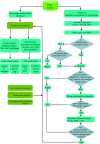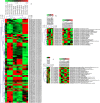Cross-species multiple environmental stress responses: An integrated approach to identify candidate genes for multiple stress tolerance in sorghum (Sorghum bicolor (L.) Moench) and related model species
- PMID: 29590108
- PMCID: PMC5873934
- DOI: 10.1371/journal.pone.0192678
Cross-species multiple environmental stress responses: An integrated approach to identify candidate genes for multiple stress tolerance in sorghum (Sorghum bicolor (L.) Moench) and related model species
Erratum in
-
Correction: Cross-species multiple environmental stress responses: An integrated approach to identify candidate genes for multiple stress tolerance in sorghum (Sorghum bicolor (L.) Moench) and related model species.PLoS One. 2018 May 3;13(5):e0197017. doi: 10.1371/journal.pone.0197017. eCollection 2018. PLoS One. 2018. PMID: 29723308 Free PMC article.
Abstract
Background: Crop response to the changing climate and unpredictable effects of global warming with adverse conditions such as drought stress has brought concerns about food security to the fore; crop yield loss is a major cause of concern in this regard. Identification of genes with multiple responses across environmental stresses is the genetic foundation that leads to crop adaptation to environmental perturbations.
Methods: In this paper, we introduce an integrated approach to assess candidate genes for multiple stress responses across-species. The approach combines ontology based semantic data integration with expression profiling, comparative genomics, phylogenomics, functional gene enrichment and gene enrichment network analysis to identify genes associated with plant stress phenotypes. Five different ontologies, viz., Gene Ontology (GO), Trait Ontology (TO), Plant Ontology (PO), Growth Ontology (GRO) and Environment Ontology (EO) were used to semantically integrate drought related information.
Results: Target genes linked to Quantitative Trait Loci (QTLs) controlling yield and stress tolerance in sorghum (Sorghum bicolor (L.) Moench) and closely related species were identified. Based on the enriched GO terms of the biological processes, 1116 sorghum genes with potential responses to 5 different stresses, such as drought (18%), salt (32%), cold (20%), heat (8%) and oxidative stress (25%) were identified to be over-expressed. Out of 169 sorghum drought responsive QTLs associated genes that were identified based on expression datasets, 56% were shown to have multiple stress responses. On the other hand, out of 168 additional genes that have been evaluated for orthologous pairs, 90% were conserved across species for drought tolerance. Over 50% of identified maize and rice genes were responsive to drought and salt stresses and were co-located within multifunctional QTLs. Among the total identified multi-stress responsive genes, 272 targets were shown to be co-localized within QTLs associated with different traits that are responsive to multiple stresses. Ontology mapping was used to validate the identified genes, while reconstruction of the phylogenetic tree was instrumental to infer the evolutionary relationship of the sorghum orthologs. The results also show specific genes responsible for various interrelated components of drought response mechanism such as drought tolerance, drought avoidance and drought escape.
Conclusions: We submit that this approach is novel and to our knowledge, has not been used previously in any other research; it enables us to perform cross-species queries for genes that are likely to be associated with multiple stress tolerance, as a means to identify novel targets for engineering stress resistance in sorghum and possibly, in other crop species.
Conflict of interest statement
Figures








Similar articles
-
An integrated and comparative approach towards identification, characterization and functional annotation of candidate genes for drought tolerance in sorghum (Sorghum bicolor (L.) Moench).BMC Genet. 2017 Dec 22;18(1):119. doi: 10.1186/s12863-017-0584-5. BMC Genet. 2017. PMID: 29273003 Free PMC article.
-
Transcriptome analysis of drought-tolerant sorghum genotype SC56 in response to water stress reveals an oxidative stress defense strategy.Mol Biol Rep. 2020 May;47(5):3291-3303. doi: 10.1007/s11033-020-05396-5. Epub 2020 Apr 17. Mol Biol Rep. 2020. PMID: 32303956 Free PMC article.
-
Genome-Wide Analysis of TCP Family Genes in Zea mays L. Identified a Role for ZmTCP42 in Drought Tolerance.Int J Mol Sci. 2019 Jun 5;20(11):2762. doi: 10.3390/ijms20112762. Int J Mol Sci. 2019. PMID: 31195663 Free PMC article.
-
Transcription Factors Associated with Abiotic and Biotic Stress Tolerance and Their Potential for Crops Improvement.Genes (Basel). 2019 Sep 30;10(10):771. doi: 10.3390/genes10100771. Genes (Basel). 2019. PMID: 31575043 Free PMC article. Review.
-
Mapping QTLs and Identification of Genes Associated with Drought Resistance in Sorghum.Methods Mol Biol. 2019;1931:11-40. doi: 10.1007/978-1-4939-9039-9_2. Methods Mol Biol. 2019. PMID: 30652280 Review.
Cited by
-
Transcriptome Profiles Reveal Key Regulatory Networks during Single and Multifactorial Stresses Coupled with Melatonin Treatment in Pitaya (Selenicereus undatus L.).Int J Mol Sci. 2024 Aug 15;25(16):8901. doi: 10.3390/ijms25168901. Int J Mol Sci. 2024. PMID: 39201587 Free PMC article.
-
Sorghum under saline conditions: responses, tolerance mechanisms, and management strategies.Planta. 2021 Jul 5;254(2):24. doi: 10.1007/s00425-021-03671-8. Planta. 2021. PMID: 34224010 Review.
-
Responses of sorghum to cold stress: A review focused on molecular breeding.Front Plant Sci. 2023 Feb 23;14:1124335. doi: 10.3389/fpls.2023.1124335. eCollection 2023. Front Plant Sci. 2023. PMID: 36909409 Free PMC article. Review.
-
Multi-locus genome-wide association mapping for major agronomic and yield-related traits in sorghum (Sorghum bicolor (L.) moench) landraces.BMC Genomics. 2025 Mar 28;26(1):304. doi: 10.1186/s12864-025-11458-4. BMC Genomics. 2025. PMID: 40155810 Free PMC article.
-
Pathways and Network Based Analysis of Candidate Genes to Reveal Cross-Talk and Specificity in the Sorghum (Sorghum bicolor (L.) Moench) Responses to Drought and It's Co-occurring Stresses.Front Genet. 2018 Nov 20;9:557. doi: 10.3389/fgene.2018.00557. eCollection 2018. Front Genet. 2018. PMID: 30515190 Free PMC article.
References
-
- Krannich CT, Maletzki L, Kurowsky C, Horn R. Network Candidate Genes in Breeding for Drought Tolerant Crops. Int J Mol Sci. 2015;16: 16378–16400. doi: 10.3390/ijms160716378 - DOI - PMC - PubMed
-
- Cooper M, Technow F, Messina C, Gho C, Totir LR. Use of Crop Growth Models with Whole-Genome Prediction: Application to a Maize Multienvironment Trial. Crop Sci. 2016;56: 2141–2156. doi: 10.2135/cropsci2015.08.0512 - DOI
-
- Pandey P, Irulappan V, Bagavathiannan MV, Senthil-Kumar M. Impact of combined abiotic and biotic stresses on plant growth and avenues for crop improvement by exploiting physio-morphological traits. Front Plant Sci. 2017;8 Available: https://www.ncbi.nlm.nih.gov/pmc/articles/PMC5394115/. Accessed May 2017. - PMC - PubMed
-
- Ramegowda V, Senthil-Kumar M. The interactive effects of simultaneous biotic and abiotic stresses on plants: Mechanistic understanding from drought and pathogen combination. J Plant Physiol. 2015;176: 47–54. doi: 10.1016/j.jplph.2014.11.008 - DOI - PubMed
Publication types
MeSH terms
LinkOut - more resources
Full Text Sources
Other Literature Sources

